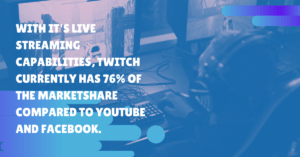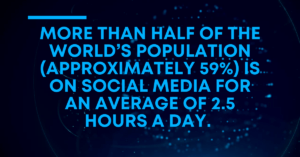The rise of ad blockers and stricter ad terms and conditions could be one of the indications toward the rise of influencer marketing. Influencers can be direct with their advertising while also retaining a sense of authenticity that brand-driven social media marketing doesn’t always have.
Not only that, but one survey revealed that 89 percent of businesses note that, upon integrating influencers into their marketing teams, they see ROIs that are comparable to or better than their other active marketing channels.
If you’re looking to bring influencers into your marketing efforts but don’t know where to begin, you’re in luck. Reaching out to influencers is easier than you might think. Using tools like Sideqik, you’ll be able to build an influencer-operated content marketing strategy that sees financial return in no time at all.
Step 1: What Are Your Goals?
Before you even start researching potential influencers to partner with, you need to establish goals for your social media strategy and each individual campaign. These goals can include the following:
- Improving brand recognition among an existing audience
- Improving brand recognition in a previously-unreached audience
- Building sales leads
- Sharing product solutions to new industry problems
If you don’t establish a clear goal and a target audience for your campaign from the get-go, you risk muddling all of your work. When you don’t have a set objective in mind, your influencers will not only lack passion for your campaign, they won’t have the clarity to approach the campaign with their full creative influence.
Keep your goals specific and timely. They should also align with your business goals. Once you have them outlined, you’ll be ready to onboard the new faces of your company.
Step 2: Identify Potential Influencers (And Your Budget)
There are different types of influencers operating on social media platforms today producing all different types of content:
- Micro-influencers – these influencers tend to have an online following of 50,000 or fewer people. Even though their reach may seem small, bringing in multiple micro-influencers allows you to target new demographics with specificity.
- Mega-influencers – think Keanu Reeves at E3 or Chris Hemsworth and designer watches. Mega-influencers are celebrities, and while they may cost you a pretty penny to bring in, they’ll definitely catch the attention of your audience.
- Bloggers – these influencers don’t operate on social media but rather have established themselves as an authority on a niche topic via a blog. They then spread their blogging content on social platforms.
- KOLs – key opinion leaders are significant figures in your industry or on its outskirts. KOL influencers and their content lend your brand a sense of authority and can work well for B2B influencer marketing.
None of these influencer types outrank any of the others. However, you’ll want to adjust your marketing budget depending on the influencers you bring to the table. Take a look at the average breakdown of influencer fees:
- Micro-influencers – $80 to $500 per post
- Mega-influencers – $3,000 to $500,000 per post
- Bloggers – $100 to $5,000 per post
- KOLs – $500 to $4,500 per post
- Organic influencers: Influencers who aren’t paid. They’re your existing fans who you get to promote your brand.
Step 3: Compare Your Audiences

You shouldn’t onboard an influencer without considering the type of audience that they reach. With diversifying consumer demographics is never a bad thing, your product and an influencer’s audiences’ interests need to align for a social media marketing strategy to be successful.
Create a list of influencers you’d be interested in working with. Then, with the help of your marketing team and tools like Sideqik, assess those consumers’ audiences. If you’re looking to connect with the millennial generation, you might want to reach out to an activist or a fashion guru who connects with your potential customers. If you’re looking to connect with sports fans, going after a pro athlete might be the right choice.
You can even get creative and think of “lookalike” audiences that may not directly seem like a fit for your brand but could be a good match. Subaru using dog-focused marketing is a great example of this. The idea is that people who like dogs can also be the same people who want outdoorsy cars.
Don’t dive into the influencer pool without keeping an audience in mind. Even if familiarization or finding new customers isn’t your primary goal, your needs should still align.
Step 4: Review Campaign Expectations
After that initial assessment, you can onboard an influencer. As you prepare to launch your marketing campaign, open the lines of communication with your influencer and make sure they understand why you’ve chosen to work with them:
- Have they worked with your brand before?
- Do you want to make waves with their audience?
- Did their content strategy and tone match yours?
- Do they actively create unique and eye-catching posts?
Once you’ve forged this connection, you can make your campaign expectations clear. Determine early on how much creative freedom your influencer has over her posts. This can be limited or vast, depending on your preference and marketing plan.
Likewise, provide them with a brief. There’ll be information they need to touch on in each of the posts they create for you, and a brief will help them stay on track in terms of content creation.
You’ll also want to schedule check-ins with your influencer to discuss post analytics and marketing strategies for future work.
Step 5: Create a Partnership Culture
The core of influencer marketing is building advocacy and trust versus something like an ad relationship. In order for your influencers to feel like “part of the team,” it’s important to treat them like it. Just like you want trust and open engagement between your chosen influencer and your target audience, build the same type of trust and open engagement between your brand and your influencer marketing partners.
If you want to streamline your social media content strategy with influencer marketing, contact Sideqik’s team of experts to learn how our all-in-one tool can help you with the process.
Nancy Rothman
Latest posts by Nancy Rothman (see all)
- How Travel Brands Can Use Influencer Marketing to Stay Afloat as the Pandemic Continues - February 22, 2022
- Influencer Marketing Trends to Watch (And Prepare For) in 2022 - December 31, 2021
- A Guide: How to Recruit the Right Influencers for Your Brand - December 30, 2021







